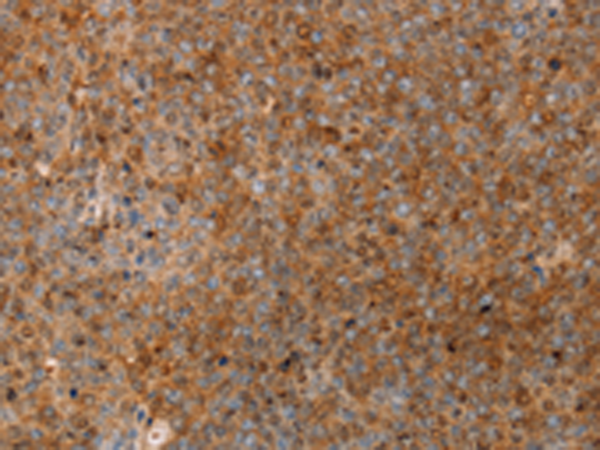
| WB | 咨询技术 | Human,Mouse,Rat |
| IF | 咨询技术 | Human,Mouse,Rat |
| IHC | 1/25-1/100 | Human,Mouse,Rat |
| ICC | 技术咨询 | Human,Mouse,Rat |
| FCM | 咨询技术 | Human,Mouse,Rat |
| Elisa | 1/1000-1/2000 | Human,Mouse,Rat |
| Aliases | PAI; PAI2; PAI-2; PLANH2; HsT1201 |
| Host/Isotype | Rabbit IgG |
| Antibody Type | Primary antibody |
| Storage | Store at 4°C short term. Aliquot and store at -20°C long term. Avoid freeze/thaw cycles. |
| Species Reactivity | Human, Mouse |
| Immunogen | Fusion protein of human SERPINB2 |
| Formulation | Purified antibody in PBS with 0.05% sodium azide and 50% glycerol. |
+ +
以下是关于SERPINB2抗体的3篇参考文献及其摘要概括:
1. **文献名称**: "The serpin PAI-2 is a native intracellular inhibitor of caspase-3 in cells undergoing apoptosis"
**作者**: Antonsson, B., et al.
**摘要**: 该研究利用SERPINB2特异性抗体,通过免疫印迹和免疫荧光技术,揭示了SERPINB2(PAI-2)在凋亡细胞中通过抑制caspase-3发挥抗凋亡作用,证实其作为细胞内调控因子的功能。
2. **文献名称**: "Plasminogen activator inhibitor type 2: potential regulator of cell migration and tumor progression"
**作者**: Schneider, D.J., et al.
**摘要**: 通过免疫组化分析SERPINB2在肿瘤组织中的表达,研究发现其高表达与肿瘤转移抑制相关,抗体技术验证了其在细胞迁移和癌症进展中的潜在调控作用。
3. **文献名称**: "The intracellular serpin PAI-2 regulates a latent checkpoint during apoptosis"
**作者**: Cubellis, M.V., et al.
**摘要**: 利用SERPINB2抗体进行亚细胞定位研究,发现PAI-2通过结合特定蛋白复合物调控细胞凋亡的“潜伏检查点”,强调了抗体在解析细胞内信号通路中的关键作用。
4. **文献名称**: "The role of plasminogen activator inhibitor-2 in cancer"
**作者**: Kwaan, H.C., Mazar, A.P.
**摘要**: 综述总结了SERPINB2(PAI-2)在肿瘤发生中的作用,强调抗体技术(如ELISA和免疫组化)在评估其作为癌症预后标志物中的应用价值。
SERPINB2. also known as plasminogen activator inhibitor type 2 (PAI-2), is a member of the serine protease inhibitor (serpin) superfamily. It is primarily expressed in placental tissues, keratinocytes, and immune cells, functioning as a regulator of extracellular matrix remodeling, cell migration, and inflammation by inhibiting urokinase-type plasminogen activator (uPA) and tissue-type plasminogen activator (tPA). SERPINB2 is implicated in diverse physiological and pathological processes, including cancer progression, thrombotic disorders, skin barrier maintenance, and immune responses. Its expression is often upregulated under stress conditions, such as hypoxia or cytokine stimulation.
SERPINB2 antibodies are essential tools for studying its biological roles and disease associations. These antibodies are widely used in techniques like Western blotting, immunohistochemistry, and ELISA to detect SERPINB2 expression levels, cellular localization, and interactions in various tissues or disease models. Both monoclonal and polyclonal antibodies are available, with specificity validated through knockdown controls or blocking peptides. Researchers utilize these antibodies to explore SERPINB2's dual roles—acting as a tumor suppressor in some cancers while promoting cell survival in others—and its potential as a biomarker for inflammatory or thrombotic diseases. Recent studies also focus on its non-inhibitory functions, including immunomodulation and intracellular signaling, expanding its relevance in biomedical research.
×